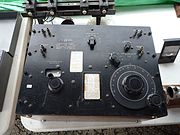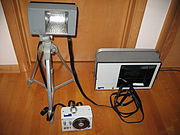History
On June 14, 1915, Melville Eastham and a small group of investors started General Radio Company in Cambridge, Massachusetts, a few blocks northwest of Massachusetts Institute of Technology. [2] During the 1950s, the company moved to West Concord, Massachusetts, where it became a major player in the automatic test equipment (ATE) business, manufacturing a line of testers for assembled printed circuit boards. It also produced extensive lines of electrical component measuring equipment, sound and vibration measurement and RLC standards. In 1975, the company name was changed to GenRad.
In 1991, a startup QuadTech [3] was founded as spinoff of GenRad's Instrumentation division and Precision Product lines, as well as the rights to use the "GenRad" and "General Radio" names. In 2000, IET Labs [4] acquired from QuadTech the GenRad RLC standards, impedance decades, megohmmeters, digibridges, audio lines, stroboscope lines. Then in 2005 IET Labs purchased the Digibridge and Megohmmeter lines, which continue to be manufactured in West Roxbury, Massachusetts. In 2001, Teradyne acquired the GenRad board test system lines, which were relocated to Teradyne's corporate campus in North Reading, Massachusetts. [1] : 240–241
Among General Radio's accomplishments over the years have been:
This page is based on this
Wikipedia article Text is available under the
CC BY-SA 4.0 license; additional terms may apply.
Images, videos and audio are available under their respective licenses.




